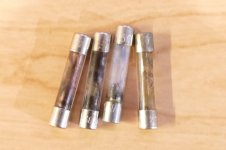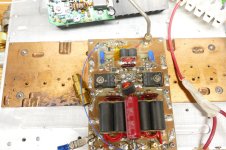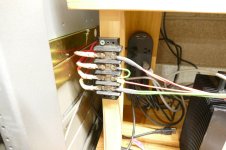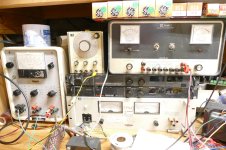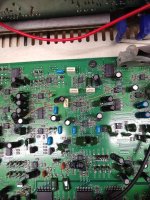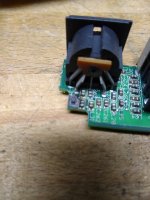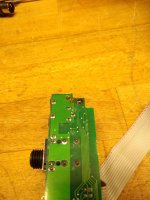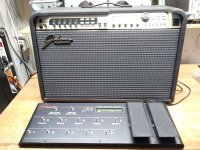A used USB External 3.5" Floppy Drive which I got on the auction site.... Wouldn't read a disk and gave an error. Tried a head cleaner to no avail. Took all the covers off down to the main mechanism and it was nearly full of lint! How the heck does all that get into an external drive which has no fan?!? Whatever... Took it to the garage and gave it a good compressed air cleanup. Works fine now. I think the crud was limiting the head mechanism's motion. Yay!
Computers are vacuum cleaners in disguise! lol!
Remember that computers lend themselves to being the bu++ of a joke. It was the OS that sucked. But when you use Linux (to rectify the original vacuum cleaner problem), /dev/fd0 requires a mount before it can be used. Someone could take that the wrong way too.
It's TPO 70 tonearm with D200E stylus. 1g is recommended tracking force for this one. Actually TF range defined for this assembly is 0.75 - 1.2g. With standard OM stylus it's of course more. I was communicating this with Ortofon.You want to track slightly on the heavy side. Tracking too light is more likely to damage your records. So if the range is 1 ~ 2 grams tracking, slightly over 1.5 gr would be better, and nothing wrong with 1.75 gr.
Yes, that is the low mass arm. I have a similar one on the TD-126 MKII I use.
In the 1970s we had issues with the AKG cartridges when they were tracking that light. Everything gets worse, acoustic feedback, sensitivity to floor vibrations.
There seems to be a happy middle ground with tracking force. Obviously not too heavy either. I wouldn't buy a cartridge that had such a low tracking force. Theory is all good, but you have to live with it day to day.
There seems to be a happy middle ground with tracking force. Obviously not too heavy either. I wouldn't buy a cartridge that had such a low tracking force. Theory is all good, but you have to live with it day to day.
Would love to know which transports you deem worthy. Thanks!Back then, Teac made some huge goofs with the CD mechanisms on their upper CD players. I did warranty for them and hated those upper machines. Overly complicated mechanical adjustments and wear points that did need to be there.
There are two basic non-starters for CD players. #1. CEC's belt drive (stupid). #2. "Stable platter" (even more stupid, upper model Teac). Both 1 and 2 try to gain sales through a connection to turntables. CD players need to run constant linear velocity, turntable are constant angular velocity. What's the difference? Turntables run at the same RPM the entire time. An off-centre record makes the pitch change with rotation. With CDs, the data rate must remain constant, so the rotation speed changes with the position from centre, and with off-centre pressings. That means it has to change speed rapidly, never mind when you skip tracks. Therefore, you absolutely do need the lowest rotating mass possible. A "stable platter" adds a huge amount of mass, and Teacs were metal, Pioneer plastic. Both a failure in engineering. Now using a belt to drive the spindle adds a compliance between the motor and spinning assembly. How is that going to correct quickly as is required? A belt is completely unnecessary and counter-productive (= stupid beyond belief).
For a very rough set of numbers, a CD player may rotate around 500 rpm near the centre, closer to 200 rpm on the outside edge. These numbers came from seminars from the manufacturers, so if anyone wants to dispute them, fine. Go measure and let us know. I never felt it important enough to waste my time doing so. The concept is what is important.
The best CD transports use a magnetic clamp, lightweight. Adding a weight like you see on turntables (bad idea anyway) again runs you into the increased rotating mass issue. There is no need to mechanically clamp the CD either.
Well, it depends. The very best transports were made by NEC in the Alpage, Nakamichi and maybe others. The Philips CDM-2 was very reliable, Studer and Revox used them (and many others).
We laughed at the Sony KSS-150A transport when it came out. Those heads had issues and were replaced with the KSS-210A. Sadly, some of the best by today's standards, along with the KSS-240A and KSS-151A. Everything became even more poorly made. THe Original Sanyo SF-90 had no slide bearings, but have a clean RF pattern. Later variants did add bearings, so I have to give them a nod.
Most Philips transports are not repairable due to the trouble aligning the swing arm. Their VAM series (linear) really hit the bottom of the barrel. Complete garbage. Units like the CDM-9 can have their disc motor replaced.
So what are the best? Look at the eye pattern from an NEC transport in something like a Nakamichi OMS-5/7 once it is set up. Compare everything to that since it is the gold standard. If the eye pattern is distorted, noisy, unstable it simply is not a good transport (or broken) no matter what any reviewer might say. This is where your information begins. Just like an FM tuner, give a tuner a good signal and it will perform well. Give an excellent tuner a poor signal and it can't perform. So you cannot retrieve accurate information from a bad eye pattern.
We laughed at the Sony KSS-150A transport when it came out. Those heads had issues and were replaced with the KSS-210A. Sadly, some of the best by today's standards, along with the KSS-240A and KSS-151A. Everything became even more poorly made. THe Original Sanyo SF-90 had no slide bearings, but have a clean RF pattern. Later variants did add bearings, so I have to give them a nod.
Most Philips transports are not repairable due to the trouble aligning the swing arm. Their VAM series (linear) really hit the bottom of the barrel. Complete garbage. Units like the CDM-9 can have their disc motor replaced.
So what are the best? Look at the eye pattern from an NEC transport in something like a Nakamichi OMS-5/7 once it is set up. Compare everything to that since it is the gold standard. If the eye pattern is distorted, noisy, unstable it simply is not a good transport (or broken) no matter what any reviewer might say. This is where your information begins. Just like an FM tuner, give a tuner a good signal and it will perform well. Give an excellent tuner a poor signal and it can't perform. So you cannot retrieve accurate information from a bad eye pattern.
Another Harvest Right freeze dryer, another easy fix. It's usually a vacuum issue. Either the pump is out of spec or a minor leak has developed. FWIW, if you're using a freeze dryer and the pump is leading to vacuum errors, it's usually still plenty good for clamping or degassing projects. If a pump is out of spec by an order of magnitude, its only off ~ 0.1lbs per Sq Inch away from full atmospheric clamping pressure.
I fixed my 10 year old heat pump. The outside unit would turn into a giant ice cube overnight on a damp cold night. Sometime in late January we had an unknown "electrical event" that blew up a Sony TV, tripped every "arc fault" breaker in the box and severely blew the AC line fuse in all of my 1990's vintage HP RF signal generators. After discovering that my heat pump had a "defrost control board" which could have been blown since that January event. Unlike the blasted fuses, the control board looked OK. The board was over $300 from an AC parts house, with sales restricted to licensed AC contractors only. Amazon had a "Genuine HK32EA001" "Factory Certified" Chinese clone board for $60 so I got one and put it in the unit. The defrost cycle now functions as it should.
The pictures show 4 fuses from the 5 signal generators, the 5th one had shattered, and the old heat pump board on top of the box that the Amazon clone board came in.
I remember being awakened by a bang in the middle of the night in late January. It was not storming or even raining. I didn't see anything unusual, the power was still on so I went back to bed thinking my neighbor had dispatched a snake with his shotgun. There are probably some more dead electronics that haven't been discovered yet.
The pictures show 4 fuses from the 5 signal generators, the 5th one had shattered, and the old heat pump board on top of the box that the Amazon clone board came in.
I remember being awakened by a bang in the middle of the night in late January. It was not storming or even raining. I didn't see anything unusual, the power was still on so I went back to bed thinking my neighbor had dispatched a snake with his shotgun. There are probably some more dead electronics that haven't been discovered yet.
Attachments
Yes, factory parts for equipment are generally over-priced. Massively overpriced.
I fixed a friends stove controller PCB. Needed a relay and ... filter caps (surprise).
I just fixed an HP 6033A I bought off Ebay, good seller sold as "for parts or repair". Turned out the 220/120 voltage conversion wasn't completely done, the fan guard was bent, lightly hitting the fan blades. Then it just needed a voltage calibration. Lucky, easy fixes!
So, cleaned up, and made a binding post interface for the output, sensing brought from the terminals.
I fixed a friends stove controller PCB. Needed a relay and ... filter caps (surprise).
I just fixed an HP 6033A I bought off Ebay, good seller sold as "for parts or repair". Turned out the 220/120 voltage conversion wasn't completely done, the fan guard was bent, lightly hitting the fan blades. Then it just needed a voltage calibration. Lucky, easy fixes!
So, cleaned up, and made a binding post interface for the output, sensing brought from the terminals.
About 10 years ago I bought a Fluke 407D power supply off Ebay as non functional "for parts or repair". The price was $25 but shipping for the big tubes and transformer powered beast was $45 from California. I plugged it in when it arrived and noticed that it appeared to work, but the meter didn't move. There was a dent in the side of the case near the meter switch. Autopsy revealed that whatever made the dent also broke the wafer switch. A bit of JB Weld and the power supply worked.I just fixed an HP 6033A I bought off Ebay, good seller sold as "for parts or repair".
I used it for my main power supply when working on tube stuff for several years until it didn't work one day. Autopsy revealed an open can cap electrolytic. I wired an axial cap across it and it still works today. All eight tubes are still the originals from 1969. Not bad for a 55 year old beast that I abuse a lot.
That Fluke is a great looking supply! Nice! That is something I wouldn't have passed up.
New test equipment sure isn't like that!
Most scavengers selling test equipment don't know how to investigate it. Unless it shows "no fly" damage, or is cooked, you can be safe repairing most of it. Shipping is a big deal for some boat anchors for sure! Try shipping an HP 3585A for example. I'd buy one of your 8657x generators for ure if it wasn't for the shipping costs! Most of their CRTs are too dim to see, no replacement. I was hoping the LCD guys in CA would come out with a kit for one of mine.
Picked up a "little" Xantrex XKW 600-1.7 for testing some amplifiers. Overkill for sure. The ancient Heathkit and a couple other tube HV regulators work great as well.
New test equipment sure isn't like that!
Most scavengers selling test equipment don't know how to investigate it. Unless it shows "no fly" damage, or is cooked, you can be safe repairing most of it. Shipping is a big deal for some boat anchors for sure! Try shipping an HP 3585A for example. I'd buy one of your 8657x generators for ure if it wasn't for the shipping costs! Most of their CRTs are too dim to see, no replacement. I was hoping the LCD guys in CA would come out with a kit for one of mine.
Picked up a "little" Xantrex XKW 600-1.7 for testing some amplifiers. Overkill for sure. The ancient Heathkit and a couple other tube HV regulators work great as well.
I have a Sorensen DCS 600-1.7 for testing the big stuff somewhat more safely than my other big power supply. The pair of Sorensens have a decent current limiter that is too slow to save a semiconductor when things go wrong, but fast enough to stop a vacuum tube from exploding! The bottom one, a DCS33-33E does 0-33V at 0-33A. There aren't too many tubes that it won't light up. The big bad boy underneath the Sorensens is an old HP6448B 60 Hz switcher. It has 1000uF of capacitance feeding the output (CLC with a pair of 500uF caps). When things go wrong parts, including a pair of 6HJ5's EXPLODE. Plating vanishes from PC boards, bad stuff happens. It has not been used in a long time.Picked up a "little" Xantrex XKW 600-1.7 for testing some amplifiers. Overkill for sure.
Over on the solid state / RF workbench, there are two more Sorensen DCS33-33Es. They are wired in series so I can get 48 volts at 33 amps. This was used for the design and testing of a 500 watt RF amp with a pair of MHT1803 300 watt RF mosfets for ham radio use on 1.6 to 54 MHz. The little green 10 watt driver board is partially visible. The DCS33-33Es were $100 each, or three for $250. I got 3.
The 600 volt Sorensen was an Ebay find in disgustingly dirty condition, which was stated in the listing. It appeared that it had been immersed in really nasty water for some time before drying out. Everything inside was encrusted in a mixture of dried mud and brown "stuff." When I got it I ran the garden hose all over the guts, followed by 3 or 4 bottles of 91% isopropyl alcohol, followed by a few days in the sun. Then I took it all apart and scrubbed down the PC board and most of the other parts with a toothbrush and some WD-40. After reassembly, it worked!
Attachments
Very nice George!
I picked up the HP 6033A for high current, low voltage stuff. My high current is a trickle charge to some for sure! Only 20 VDC, 30 amperes. I've also got a Heathkit IP2715, 16 VDC and 20 amperes. That was built back in the day when car amplifiers didn't draw much, and it would have been more for mobile transmitter service I think.
Yes, I use the current limit on the Xantrex! That much energy would lay waste to most consumer tube amplifiers.
George, you have way too much fun! lol!
I picked up the HP 6033A for high current, low voltage stuff. My high current is a trickle charge to some for sure! Only 20 VDC, 30 amperes. I've also got a Heathkit IP2715, 16 VDC and 20 amperes. That was built back in the day when car amplifiers didn't draw much, and it would have been more for mobile transmitter service I think.
Yes, I use the current limit on the Xantrex! That much energy would lay waste to most consumer tube amplifiers.
George, you have way too much fun! lol!
A Johnson Millenium 150 guitar amp recently was on my workbench. This is a stereo guitar combo fitted with 2x 12“ Celestion speakers, providing amp modelling, a multitude of effects and 100 digital stored presets. A nice built sophisticated design and for my knowledge the first commercially available modelling amp which is legendary since. Sadly a very rare bird, production ceased about 20yrs ago, there is not much you can find actually on the internet about it. Luckily two original schematics could be downloaded – otherwise I would have been lost.
The customer said that from that 100 presets only a few were working, i.e. produced any sound although the display showed them all. So I checked the CMOS battery at first. It measured 3,15V – no probs here. Next idea was some defunct CMOS multiplexers that might have burnt. I made a list of them, checked them – and everything looked fine. Running out of ideas I played with the front knobs and discovered that the few working presets all used the first amp model and channel B. So I decided to trace the hole signal path inserting a sine wave into the input jack and monitoring all stages with a signal monitor. In that case simply a tiny guitar practice amp. At the end I found a broken connection in the analog front end, connected with a patch wire and all the presets were back again.
Next issue was the „dead“ foot controller board. This is connected via MIDI cable. There was no 5V supply powering the controller. Tracing this back I ended at the MIDI pcb of the amp and discovered a melted down ferrite-bead in the +5V rail. Replaced it with some patch wire and that did the trick. I guess some cable short-circuit caused this failure.
All in all re-animation of this baby took a hole day and a night to make the customer happy again.
The customer said that from that 100 presets only a few were working, i.e. produced any sound although the display showed them all. So I checked the CMOS battery at first. It measured 3,15V – no probs here. Next idea was some defunct CMOS multiplexers that might have burnt. I made a list of them, checked them – and everything looked fine. Running out of ideas I played with the front knobs and discovered that the few working presets all used the first amp model and channel B. So I decided to trace the hole signal path inserting a sine wave into the input jack and monitoring all stages with a signal monitor. In that case simply a tiny guitar practice amp. At the end I found a broken connection in the analog front end, connected with a patch wire and all the presets were back again.
Next issue was the „dead“ foot controller board. This is connected via MIDI cable. There was no 5V supply powering the controller. Tracing this back I ended at the MIDI pcb of the amp and discovered a melted down ferrite-bead in the +5V rail. Replaced it with some patch wire and that did the trick. I guess some cable short-circuit caused this failure.
All in all re-animation of this baby took a hole day and a night to make the customer happy again.
Attachments
Pressure gauge failed.
Old, 1993, inspection revealed needle link to Bourdon Tube was soldered, had failed.
Got out my big iron, soldered it back, had to file with a needle file on both faces for better bonding.
Should work, will check tomorrow with compressed air, then fit it to oil line (toggle lube pump, 12 kilos pressure, timer controlled).
Old, 1993, inspection revealed needle link to Bourdon Tube was soldered, had failed.
Got out my big iron, soldered it back, had to file with a needle file on both faces for better bonding.
Should work, will check tomorrow with compressed air, then fit it to oil line (toggle lube pump, 12 kilos pressure, timer controlled).
- Home
- Member Areas
- The Lounge
- What did you last repair?
